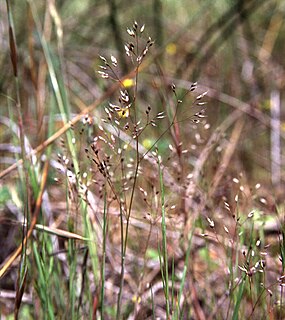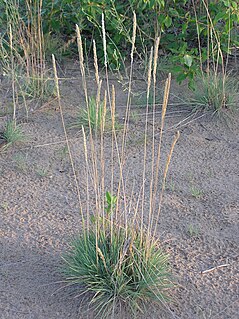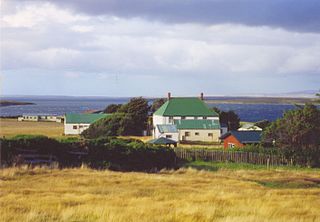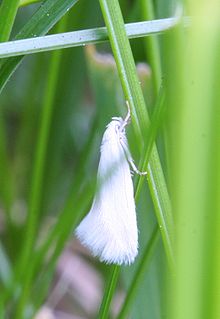
Aira is a genus of Old World plants in the grass family, native to western and southern Europe, central and southwest Asia, plus Africa.
Hair grass is a common name for several plants and can refer to:

Purn Hill is a 6.1 hectare biological Site of Special Scientific Interest near the village of Bleadon, Somerset, notified in 1990. The site is a small promontory of Carboniferous Limestone projecting southward from the main Mendip ridge.

Koeleria is a common and widespread genus of plants in the grass family, found on all continents except Antarctica and on various oceanic islands. It includes species known generally as Junegrasses.

Koeleria glauca, commonly known as blue hair grass, is a grass species of the genus Koeleria. It grows in dunes and other sandy places. It is mainly distributed in eastern Central Europe, with its western outposts in the coastal dunes of Jutland and inland dunes in the Rhine Valley.

Koeleria pyramidata is a Eurasian plant species in the grass family. It is found in grasslands from France + Denmark to Nepal + Siberia.
NVC community CG1 is one of the calcicolous grassland communities in the British National Vegetation Classification system. It is one of three short-sward communities associated with heavy grazing, within the lowland calcicolous grassland group, and is regarded as the south-west coastal counterpart of "typical" chalk grassland.

Koeleria macrantha is a species of grass known by the common name prairie Junegrass in North America and crested hair-grass in the UK. It is widespread across much of Eurasia and North America. It occurs in many habitat types, especially prairie.

Tussock grasses or bunch grasses are a group of grass species in the family Poaceae. They usually grow as singular plants in clumps, tufts, hummocks, or bunches, rather than forming a sod or lawn, in meadows, grasslands, and prairies. As perennial plants, most species live more than one season. Tussock grasses are often found as forage in pastures and ornamental grasses in gardens.
Tussock grassland is a form of open grassland that is dominated by tussock grasses. It is common in some temperate grasslands, savannas, and shrublands ecoregions of the Southern Hemisphere. Tussock grasslands are usually typified by low rainfall and poor soils in which few plants other than hardy tussock grasses can flourish. They are predominantly populated by tufted grasses of the genera Agrostis, Andropogon, Chionochloa, Deschampsia, Festuca, Koeleria, Pentameris and Poa. The grasslands are found in New Zealand, Australia, Argentina, temperate areas of southern and eastern Africa, and some subantarctic islands.

Elachista argentella is a moth of the family Elachistidae found in all of Europe, except the Balkan Peninsula.

Sesleria is a Eurasian and North African genus of perennial plants in the grass family.

Koeleria vallesiana, the Somerset hair grass, is a grass species of the genus Koeleria. It grows in Europe, temperate Asia, and North America.

Elachista herrichii is a moth of the family Elachistidae. It is found from the Baltic region to the Pyrenees, Italy and Romania.

Lupinus sericeus is a species of flowering plant in the legume family known by the common name silky lupine or Pursh's silky lupine. It is native to western North America from British Columbia to Arizona and east to Alberta and Colorado.

Potentilla hippiana is a species of flowering plant in the rose family known by the common names woolly cinquefoil, horse cinquefoil, and Hipp's cinquefoil. It is native to North America, where it occurs in western Canada and the western United States. It occurs in eastern Canada and the US state of Michigan as an introduced species.
Physaria fremontii is a species of flowering plant in the family Brassicaceae known by the common name Fremont's bladderpod. It is endemic to Wyoming in the United States, where it occurs only in and around the Wind River Range in Fremont County.

Neoparrya lithophila, also known by the common names Bill's neoparrya and rock-loving aletes, is a species of flowering plant in the carrot family. It sometimes treated as the sole member of the monotypic genus Neoparrya, though other treatments place it in the genus Aletes.
Parafestuca is a genus of plants in the grass family. The only known species is Parafestuca albida, found only on the Portuguese Island of Madeira in the North Atlantic.
Turgeniopsis is a monotypic genus of flowering plants belonging to the family Apiaceae. It only contains one known species, Turgeniopsis foeniculacea(Fenzl) Boiss.













